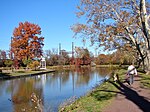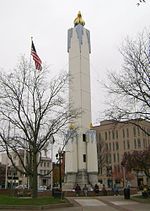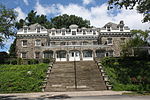Lehigh River

The Lehigh River is a 109-mile-long (175 km) tributary of the Delaware River in eastern Pennsylvania. The river flows in a generally southward pattern from the Pocono Mountains in Northeastern Pennsylvania through Allentown and much of the Lehigh Valley before joining the Delaware River in Easton. Part of the Lehigh River and a number of its tributaries are designated Pennsylvania Scenic Rivers by the state's Department of Conservation and Natural Resources. The river's name is an anglicisation of the Lenape name for the river, Lechewuekink, which means "where there are forks". Both Lehigh County and Lehigh Valley are named for the river. Between 1821 and 1966, the Lehigh River was owned by the Lehigh Coal and Navigation Company, making it the only privately owned river in the United States. This private ownership continued until a local representative, Samuel Frank, promoted a bill to return control of the river to the state in 1967. According to an environmental report from a Pennsylvania nonprofit research center, the Lehigh River watershed is ranked second nationally in the volume of toxic substances released into it in 2020. The study mirrored a previous report by the state's Department of Environmental Protection that found most of the county's waterways unsafe for swimming or aquatic life.
Excerpt from the Wikipedia article Lehigh River (License: CC BY-SA 3.0, Authors, Images).Lehigh River
D&L Trail, Easton
Geographical coordinates (GPS) Address Nearby Places Show on map
Geographical coordinates (GPS)
| Latitude | Longitude |
|---|---|
| N 40.688888888889 ° | E -75.204722222222 ° |
Address
D&L Trail
D&L Trail
18042 Easton
Pennsylvania, United States
Open on Google Maps











